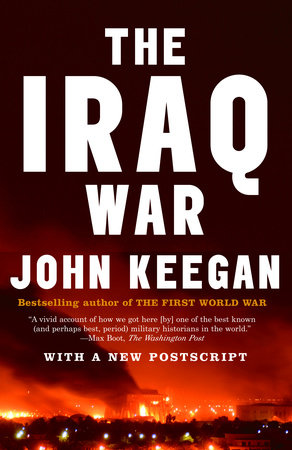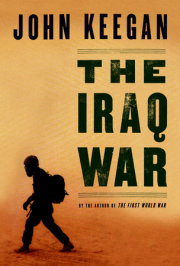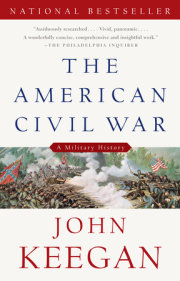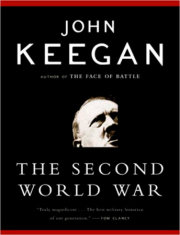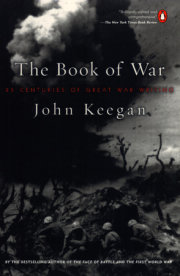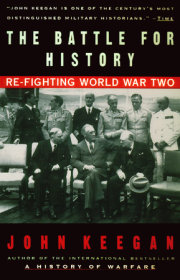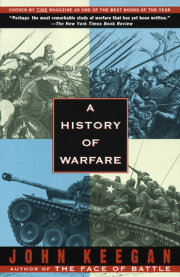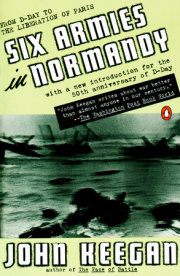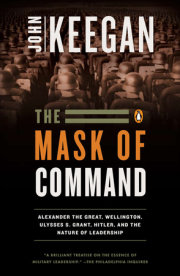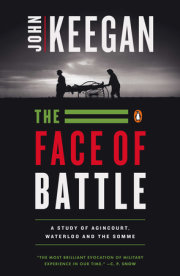chapter 1
1
A Mysterious War
Some wars begin badly. Some end badly. The Iraq War of 2003 was exceptional in both beginning well for the Anglo-American force that waged it and ending victoriously. The credit properly belonged in both cases to the American part of the coalition. It was the Americans who provided the majority of strength on the ground and overwhelmingly the majority in the air and at sea. The British contribution was important and warmly welcomed by the Americans but it was that of an esteemed junior partner.
The war was not only successful but peremptorily short, lasting only twenty-one days, from 20 March to 9 April. Campaigns so brief are rare, a lightning campaign so complete in its results almost unprecedented. For comparisons one has to reach back to the ‘cabinet wars’ of the nineteenth century, Prussia’s victory over Austria in six weeks in 1866 or over the French field army in less than a month in 1870. Walkovers, as by the Germans in the Balkans in 1941, do not count. The Iraqis had fielded a sizeable army and had fought, after a fashion. Their resistance had simply been without discernible effect. The Americans came, saw, conquered. How?
While reporting the war in The Daily Telegraph I frequently found myself writing that its events were ‘mysterious’. It was a strange word for a military analyst to use in what should have been objective comment. Even in retrospect, however, I see no reason to look for another. The war was mysterious in almost every aspect. Mystery shrouded the casus belli, the justification for going to war. The war was launched because Saddam Hussein, President of Iraq, refused to co-operate with United Nations inspectors in their search for his forbidden weapons of mass destruction. Yet even after his defeat laid the whole territory of Iraq open to search, such weapons eluded discovery. Mystery surrounded the progress of operations. Iraq fielded an army of nearly 400,000 soldiers, equipped with thousands of tanks, armoured vehicles and artillery pieces. Against the advance of an invading force only half its size, the Iraqi army faded away. It did not fight at the frontier, it did not fight at the obvious geographical obstacles, it scarcely fought in the cities, it did not mount a last-ditch defence of the capital, where much of the world media predicted that Saddam would stage his Stalingrad.
The régime, so bombastic in speech before and during the conflict, mysteriously failed to take elementary defensive precautions. In a country of great rivers, the Euphrates and Tigris pre-eminently but also their tributaries, it failed to destroy the bridges, or even in many cases to prepare them for demolition. While the regular army and the vaunted Republican Guard apparently demobilized themselves, the soldiers disappearing to their homes at the appearance of the invaders, their place was taken by mysterious ‘fighters’ of the skimpiest military training, devotees of the ruling Ba’athist party or foreign Islamicists with an urge to die. Perhaps most mysteriously of all, much of the population of Iraq, the ordinary town dwellers and country people, exhibited a complete indifference to the war going on around them, carrying on their everyday lives apparently oblivious of its dangers. To the bewilderment and fury of the coalition soldiers, traffic often travelled as normal, civilian cars and trucks proceeding headlong into the middle of firefights and stopping only if shot at, by young soldiers terrified that the driver might be a suicide bomber.
Mystery ultimately enfolded the fall of the régime. Following the capture and occupation of Baghdad on 9–10 April, no trace of the government could be found. Not only was there no large number of prisoners of war, the usual index of victory, there were equally no captured generals or staff officers nor, most puzzlingly of all, politicians treating for peace. The Ba’ath leaders and their party officials had disappeared, just as the army and the Republican Guard had disappeared. The disappearance of the soldiers was easily explained. They had taken off their uniforms and become civilians again. The disappearance of the leaders was baffling. It was understandable that, fearing retribution for the crimes of the régime, summarily at the hands of the population, judicially by process of the conquerors, the principal perpetrators and their associates should seek to make their escape; but where had they gone? The American high command distributed packs of cards, each bearing the photographic image of a wanted man. The distribution yielded results. The owlish Tariq Aziz, Deputy Prime Minister, was arrested. So were a number of other important if less prominent Saddam apparatchiks. On 22 July 2003 Saddam Hussein’s sons Qusay and Uday, both steeped in the brutality against political opponents which was their father’s trademark, were betrayed, by the inducement of a $15 million reward, and killed during a gun battle in the northern city of Mosul. Kurdistan might have been thought an ill-chosen hiding place for the dictator’s sons. One of the most extreme Islamicist terror organizations, Ansar al-Islam, had however set up what amounted to a ‘liberated zone’ in Kurdistan, so perhaps encouraging the two thugs – whom Saddam had hardened to their inheritance by sending them to witness torture and executions – to seek refuge there.
The final mystery of the whereabouts of the dictator himself persisted. In the immediate aftermath of the defeat rumours circulated that he had made his escape to a friendly Muslim country. The rumours were cumulatively discounted. Such stable régimes, Libya or Syria, as might have been willing to welcome him were also prudently cautious of the danger of offending the United States. Countries where anti-Americanism flourished, such as Yemen or Somalia, were judged too unstable for Saddam to risk his survival in their turbulent politics. The occupation authority in Iraq eventually concluded that he remained within the country, probably hidden by family or tribal supporters in his home area around Tikrit. Frequent searches were mounted without result. A more methodical procedure proved productive. An intelligence team, by working through his family tree, identified the whereabouts in the Tikrit neighbourhood of residents who might be sheltering him. On 13 December 2003 a party of American troops from the 4th Infantry Division, revisiting a farm already searched but now with better information, uncovered the entrance to an underground hiding place. When the trapdoor was lifted, a bedraggled and heavily bearded Saddam was found cowering inside. He held up his hands and announced, ‘I am the President of Iraq and I am ready to negotiate.’ He was swiftly transferred to American military custody.
Saddam’s arrest put an end to the last contingent mystery of the war. A greater mystery remained, attaching not to the war’s events but to its fundamental character. How had it been possible to fight a war which was not, by any conventional measure, really a war at all? All the components of a war had been in place, two large armies, huge quantities of military equipment and, that most essential element of modern hostilities, an enormous press corps, equipped and alert to report, film or broadcast its slightest incident. Beyond the battleground, moreover, the world had been transfixed by a war mood. Governments had been thrown at loggerheads over the war’s rights and wrongs, the workings of the great international organizations had been monopolized by debate over the war, populations had marched against the war, the world’s religious leaders had uttered the direst warnings about the war’s outcome, the international media had written and spoken about little else but war for weeks before, during and afterwards. Yet, when war engulfed their country, the people who ought to have been most affected by it, the population of Iraq itself, seemed scarcely to give it their attention. American cheerleaders had predicted that the invading army would be overwhelmed by the gratitude of the liberated once it appeared on Iraqi territory. Opponents of the war, particularly in the media, puzzled at first by the lack of opposition the invaders encountered, consoled themselves with a prediction of their own: that when the American army reached Baghdad, it would be resisted block by block, street by street. There would be a Stalingrad-on-Tigris and the West would regret that it had ever flouted high-minded opinion by mounting such an expedition.
In the event, the invaders found the population largely absent from the scene of action. There were no crowds, either welcoming or hostile. There were scarcely any people to be seen at all. In the countryside the mud hut dwellings of the cultivators displayed at best a scrap of white flag, flapping from a stick, as a sign the occupants recognized that a war was in progress. Often they gave no sign at all. Herders and ploughmen wended their heedless way about the landscape. Mothers shooed their children to shelter at the sight of military vehicles. Camel drivers stood to gaze. Otherwise the dusty countryside lay empty under a pall of apparent indifference at the world crisis that had come to visit Iraq.
Civilian unwillingness to engage with the war was matched, and more than matched, by that of the rank and file of the Iraqi army. Saddam commanded some 400,000 men in uniform, 60,000 of them in his loyalist Republican Guard. Few were well trained and most of their military equipment, once of the Soviet first-line, was now antiquated. The coalition high command nevertheless expected them to fight. Its soldiers, particularly the younger men who had never been in battles, were spoiling to meet the challenge. They were to be largely disappointed. Here and there they found spots of resistance, Iraqi infantrymen who manned their positions, tank crews who exchanged fire. In most cases as the invaders advanced to places where defences had been prepared, however, they found them abandoned, often clearly in the last minutes before action threatened. Pathetic scraps of evidence of occupation lay about, pots of rice, packets of tea, newspapers, discarded clothing and even abandoned boots and weapons. The owners had fled, not to better positions or to regroup, but to go home. Western military intelligence officers identified two waves of desertion: the first following coalition air attack preceding the advance, a second as the sound of approaching coalition armour was heard. By the time the coalition forces actually appeared, the Iraqi soldiers were gone, to disappear into the civilian population and not to be seen again.
The phenomenon was disconcerting, particularly to military theorists committed to the view that war is animated by politics. Such theorists expect the defenders of a country under attack to resist, because the attack threatens the essentials of their society. They accept the reality of collapse, such as that which overwhelmed France in 1940, but associate collapse with objective military events, such as encirclement or deep penetration of a flank. Failure to fight altogether defies their theories, particularly their central theory that military structures are an amalgam of army, government and people. The circumstances of Iraq in 2003 demonstrate that classical military theory applies only to the countries in which it was made, those of the advanced Western world. Elsewhere, and particularly in the artificial, ex-colonial territories of the developing world, usually governed as tyrannies, it does not. Iraq is a particularly artificial construction; three former provinces of the Ottoman Empire, each inhabited by disparate populations, ethnically and religiously separate from one another. The central and southern regions are respectively Sunni and Shi’a Muslim Arab, the north, though Muslim, not Arab at all but Kurdish. The Ottoman Turks had not treated the three regions as a unit but ruled them separately. It was the British, exercising a League of Nations mandate, who had attempted to unify the country and bequeathed their shaky creation to the successor governments. It had worked erratically at best and only by according dominance to the Sunni of the centre. Monarchy had been supplanted by dictatorship, eventually, in its most ruthless form, that of Saddam Hussein.
Saddam had tested his dictatorship to its limits. Had he been content merely to modernize, spending his country’s vast oil revenues for the benefit of all, he might have made Iraq a successful country. Modernize he did, but out of megalomaniac ambition he also attempted to establish Iraq as the dominant Middle Eastern state, a regional military superpower. He waged internal war against the Kurds. He dragooned his population into a costly invasion of neighbouring Iran over a trivial border dispute. He finally provoked a war with the world by an aggression against Kuwait designed to pay his debts.
Defeated and humiliated, he persisted in playing the big man, refusing to demonstrate to the United Nations that he had desisted from developing the weapons of mass destruction with which he had buttressed his ambition. For twelve years, between 1991 and 2003, he fenced with the United Nations and its supporters, the United States foremost, over inspection and disclosure. Eventually, having exhausted American patience, he was confronted by the challenge of war again. He declined to offer the facilities and guarantees that would have staved off the consequences of his intransigence. He thus brought war on himself.
It was not a war into which the peoples of Iraq would follow him. In one sense Western military theorists were right. Ordinary Iraqis ought to have been willing to fight to defend their homeland, as theory dictated, had Iraq been an ordinary country. Iraq, however, was not an ordinary country. It was not merely an artificial creation; it was also a monstrosity. Artificial states, of which there are many in the world, can survive for long periods through the medium of carefully calculated concessions by the dominant centre to the minorities. Saddam did not concede. He brutalized. Not only were individual opponents of his régime tortured and murdered; whole sections of the population were murdered also, while those not currently chosen for Saddam’s cruelties were held in check by fear of his disfavour.
Ultimately there is no mystery about the collapse of Saddam’s régime and the failure of his people to fight his last war. Saddam had waged war against Iraq itself, repeatedly, relentlessly, revengefully. He had exhausted the will of the population to do anything for him and it was entirely appropriate that he should have been driven as a last resort to seek refuge underground in the soil of his tortured country.
2
Iraq Before Saddam
‘Iraq’ in Arabic means the shore of the great river and the fertile land surrounding it. The word has been used since at least the eighth century ad to describe the alluvial plain of the Tigris and Euphrates valley, known in Europe since Antiquity by the Greek term ‘Mesopotamia’, the land between the rivers.
Copyright © 2005 by John Keegan. All rights reserved. No part of this excerpt may be reproduced or reprinted without permission in writing from the publisher.

